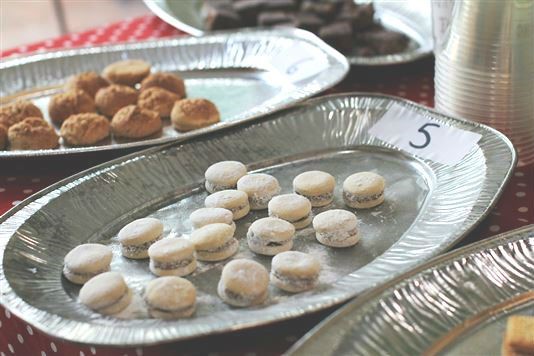Judging at the Free From Awards

The editor of The Vegetarian magazine discusses the issues around ‘free from’ food, and why blanket bans on ingredients are not necessarily the answer.
Judging at this year’s Free From Awards has just finished. Now in their seventh year, the awards (like the ‘free from’ food sector itself) are growing rapidly, with close to 50 entries in some categories. It took six days to work our way through 16 categories, including breakfast foods, ‘food to go’, and even gluten-free beers.
I volunteered to help judge the meat-free meals category, and as I was there I signed up for the sweet biscuits too. I spent the hottest hours of last summer working on a book about vegan, gluten-free baking, which was a serious challenge. I’m not ashamed to admit that there were moments when I sat on the kitchen floor feeling pretty defeated. After that, I felt I had earned the right to judge other people’s biscuits.
I’ve grown accustomed to the kind of chat that goes on between food judges at events such as the Great Taste Awards and the International Cheese Awards, and expected to find myself surrounded by opinionated foodies. With hindsight, I shouldn’t have been surprised to find that all the other judges were either suffering from food allergies themselves, or bringing up children with allergies. I felt a bit of a fraud as, although I choose not to eat meat, I have no food allergies and I didn’t feel any need to scrutinise the ingredients of every biscuit that was put in front of me.
A parent's worst nightmare
I assumed that gluten would be the big issue when it came to creating baked goods suitable for people with allergies but, really, I had no idea what some people are up against.
Mel, whose blog is piginthekitchen.co.uk, has a daughter with allergies to milk, eggs, Brazil nuts, mustard and “all kinds of pollen”.
Alexa, whose blog is yesnobananas.wordpress.com, has a toddler, Sidney, who is allergic to eggs, peanuts, tree nuts, sesame, lentils, chickpeas, green peas and “probably kiwi fruit”. Sidney carries an EpiPen in case a mistake or accident with food triggers anaphylaxis – a life-threatening allergic reaction. Alexa has a new baby daughter, Sadie, who is currently being tested for food allergies. Last summer, Alexa blogged about an incident when a well-meaning toddler pushed a finger covered in ice cream into Sadie’s mouth. She says she cried when she thought about what would have happened if the baby in the buggy had been Sidney, not Sadie.
“It’s incidents like this – brief, over-before-you-know-it moments – that freak the living daylights out of allergy parents,” said Alexa. “It’s why I can’t let Sidney out of my sight for more than a few seconds. Even if he’s playing happily in the long grass with his chums, I have to keep looking around to check there are no toddlers lurking in the shrubbery bearing peanut butter sandwiches, or pools of spilled eggy ice cream waiting for him to slip and land a bare leg in.”
Why schools have got it wrong
The reaction of schools to the arrival of allergic pupils is, according to my fellow judges, inconsistent and based on knee-jerk reactions and an incomplete understanding of the facts. Blanket bans on peanuts are just a nuisance when your child has multiple, complicated allergies, but peanut butter is one of the more nutritious sandwich fillings she can tolerate. One mum said that the coconut oil-based sunscreen that schoolkids were plastered with during the summer term was a far more serious threat to her child.
Taking the biscuit
It’s common for people who have one food allergy to have many food allergies, and one man’s meat can easily be another man’s poison. Food allergy sufferers club together under a single heading, but in fact their requirements are many and varied, and cannot be taken lightly.
Gathering around a table covered with biscuits highlighted the dilemma for food manufacturers. There were 16 biscuits for us to try. Two of them contained gelatine and so were out of bounds for me. For the rest of the group, the acceptance rate varied wildly. Each entry was accompanied by a form listing the ingredients, with known potential allergens in bold.
Sarah, who writes a blog about natural beauty, allergies and eczema (sugarpuffish.blogspot.co.uk), turned a blind eye to the food and ploughed through the paperwork before announcing that, among the 16 entries for the award, there were only two that she could safely eat. Sarah is allergic to milk, eggs, yeast, oranges, strawberries, melons, kiwis, grapefruit, piccalilli and lobster. Sitting on grass brings her out in a blistering rash. But peanuts are not a problem.
Some allergy sufferers argue that manufacturers who are targeting the ‘free from’ market need to make sure that everything they make is free from every known allergen. Others don’t see why: just because they’re allergic to dairy products, why should they be forced to buy food that is also free from wheat, eggs and nuts? So creating a biscuit that ticks all the ‘free from’ boxes but still represents a bit of a treat is very tricky.
The shortlists for the Free From Awards 2014 are now online here. The Awards Ceremony will take place on 25th March in London.
You might also like
Comments
Be the first to comment
Do you want to comment on this article? You need to be signed in for this feature